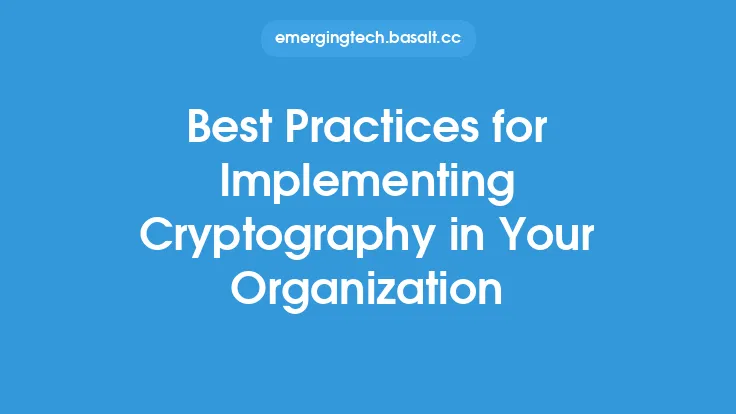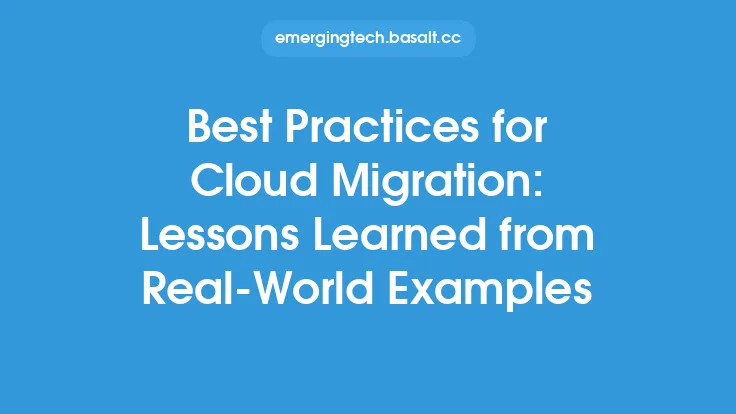As organizations continue to migrate their infrastructure and applications to the cloud, effective cloud management has become a critical component of their overall IT strategy. Cloud management involves a range of activities, including provisioning, monitoring, and optimizing cloud resources, as well as ensuring security, compliance, and cost control. In this article, we will explore the best practices for effective cloud management, and provide guidance on how organizations can get the most out of their cloud investments.
Introduction to Cloud Management Best Practices
Effective cloud management requires a combination of people, processes, and technology. It involves understanding the organization's cloud usage patterns, identifying areas for optimization, and implementing strategies to improve efficiency, reduce costs, and enhance security. Cloud management best practices include establishing clear policies and procedures, monitoring and analyzing cloud usage, and implementing automation and orchestration tools to streamline cloud management tasks. Additionally, organizations should prioritize security and compliance, and ensure that their cloud management practices align with their overall business objectives.
Cloud Governance and Compliance
Cloud governance and compliance are critical components of effective cloud management. Organizations must ensure that their cloud usage complies with relevant laws, regulations, and industry standards, such as HIPAA, PCI-DSS, and GDPR. This involves implementing policies and procedures for data management, access control, and auditing, as well as ensuring that cloud providers meet the necessary compliance requirements. Cloud governance also involves establishing clear roles and responsibilities, and ensuring that cloud management practices are aligned with the organization's overall IT strategy.
Cloud Cost Management
Cloud cost management is a key aspect of effective cloud management. Organizations must ensure that they are getting the best possible value from their cloud investments, and that they are not overspending on cloud resources. This involves monitoring and analyzing cloud usage, identifying areas for optimization, and implementing strategies to reduce costs, such as rightsizing resources, using reserved instances, and taking advantage of discounts and promotions. Cloud cost management also involves establishing clear budgeting and forecasting processes, and ensuring that cloud costs are aligned with the organization's overall business objectives.
Cloud Security and Risk Management
Cloud security and risk management are critical components of effective cloud management. Organizations must ensure that their cloud resources are secure, and that they are protected against cyber threats and data breaches. This involves implementing security controls, such as firewalls, intrusion detection, and encryption, as well as ensuring that cloud providers meet the necessary security requirements. Cloud security also involves establishing clear incident response plans, and ensuring that cloud management practices are aligned with the organization's overall security strategy.
Cloud Monitoring and Analytics
Cloud monitoring and analytics are essential for effective cloud management. Organizations must be able to monitor and analyze their cloud usage, in order to identify areas for optimization, and to ensure that their cloud resources are running efficiently. This involves implementing monitoring tools, such as cloud-based monitoring platforms, and analytics tools, such as cloud-based analytics platforms. Cloud monitoring and analytics also involve establishing clear dashboards and reporting processes, and ensuring that cloud management practices are aligned with the organization's overall business objectives.
Cloud Automation and Orchestration
Cloud automation and orchestration are key components of effective cloud management. Organizations must be able to automate and orchestrate their cloud management tasks, in order to improve efficiency, reduce costs, and enhance security. This involves implementing automation tools, such as cloud-based automation platforms, and orchestration tools, such as cloud-based orchestration platforms. Cloud automation and orchestration also involve establishing clear workflows and processes, and ensuring that cloud management practices are aligned with the organization's overall IT strategy.
Cloud Management Tools and Technologies
There are a range of cloud management tools and technologies available, including cloud management platforms, cloud monitoring platforms, cloud analytics platforms, and cloud automation platforms. These tools and technologies can help organizations to improve their cloud management practices, and to get the most out of their cloud investments. When selecting cloud management tools and technologies, organizations should consider factors such as functionality, scalability, security, and cost, as well as the level of support and maintenance required.
Conclusion
Effective cloud management is critical for organizations that want to get the most out of their cloud investments. By following best practices, such as establishing clear policies and procedures, monitoring and analyzing cloud usage, and implementing automation and orchestration tools, organizations can improve their cloud management practices, and achieve their business objectives. Additionally, organizations should prioritize security and compliance, and ensure that their cloud management practices align with their overall IT strategy. By taking a proactive and strategic approach to cloud management, organizations can unlock the full potential of the cloud, and achieve greater agility, flexibility, and cost savings.





